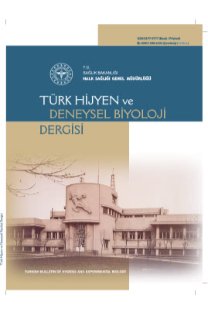Outbreak of lead toxicity during rebar production in a steel mill
İnşaat demiri üreten bir çelik fabrikasında görülen kurşun zehirlenmesi salgını
___
1. Holland MG, Cawthon D. Workplace lead exposure. J Occup Environ Med, 2016; 58 (12): 371-4.2. Guidelines for the lead-exposed worker, occupational lead poisoning prevention program. https://www.cdph.ca.gov/Programs/CCDPHP/ D E O D C / O H B / O L P P P / C D P H % 2 0 D o c u m e n t % 2 0 Library/medgdln.pdf, Accessed Date: March 30, 2019.
3. Reference Blood Lead Levels (BLLs) for Adults in the U. S, https://www.cdc.gov/niosh/topics/ ables/ReferenceBlood lead levels (BLLs) for adults in the U.S., Accessed Date: April 02, 2019.
4. Lead, elevated blood levels 2016 case Definition h t t p s : / / w w w n . c d c . g o v / n n d s s / c o n d i t i o n s leadelevated-blood-levels/case-definition/2016/, Accessed Date: April 02, 2019.
5. Kim HC, Jang TW, Chae HJ, Choi WJ, Ha MN, Ye BJ, et al. Evaluation and management of lead exposure. Ann Occup Environ Med, 2015; 15: 27-30.
6. Lewis R, Kosnet MJ. Metals. In: Ladou J, Harrison R, eds. Current Diagnosis&Treatment, Occupational and Environmental Medicine. 5th Ed. New York: McGraw-Hill Education, 2014: 1044-1096.
7. Chettle DR, Scott MC, Somervaille LJ. Lead in bone: sampling and quantitation using K X-rays excited by 109Cd. Environ Health Perspect, 1991; 91: 49-55.
8. Measures for working with chemical substances http://www.mevzuat.gov.tr/Metin.Aspx?MevzuatK od=7.5.18709&MevzuatIliski=0&sourceXmlSearch, Accessed Date: April 01, 2019.
9. NIOSH pocket guide to chemical Hazards. https:// www.cdc.gov/niosh/docs/2005-149/pdfs/2005- 149.pdf, Accessed Date: April 02, 2019.
10. Anonymous. Regulations and guidelines applicable to lead and lead compounds. OSHA, 2014; 403-13. 11. Basaran N, Undeger U. Effects of lead on immune parameters in occupationally exposed workers. Am J Ind Med, 2000; 38: 349-54.
12. Duydu Y, Suzen HS, Aydin A, Cander O, Uysal H, Isimer A, et al. Correlation between lead exposure indicators and sister chromatid exchange (SCE) frequencies in lymphocytes from inorganic lead exposed workers. Arch Environ Contam Toxicol, 2001; 41 (2): 241-6.
13. Sonmez F, Donmez O, Sonmez HM, Keskinoglu A, Kabasakal C, Mir S. Lead exposure and urinary N-acetyl beta D glucosaminidase activity in adolescent workers in auto repair workshops. J Adolesc Health, 2002; 30(3): 213-6.
14. Duydu Y, Suzen HS. Influence of delta-aminolevulinic acid dehydratase (ALAD) polymorphism on the frequency of sister chromatid exchange (SCE) and the number of high-frequency cells (HFCs) in lymphocytes from lead-exposed workers. Mutat Res, 2003; 540 (1): 79-88.
15. Gurer OH, Sabir HU, Ozgunes H. Correlation between clinical indicators of lead poisoning and oxidative stress parameters in controls and leadexposed workers. Toxicology, 2004; 195 (2–3): 147- 54.
16. Duydu Y, Dur A, Suzen HS. Evaluation of increased proportion of cells with unusually high sister chromatid exchange counts as a cytogenetic biomarker for lead exposure. Biol Trace Elem Res, 2005; 104 (2): 121-9.
17. Karakaya AE, Ozcagli E, Ertas N, Sardas S. Assessment of abnormal DNA repair responses and genotoxic effects in lead exposed workers. Am J Ind Med, 2005; 47 (4): 358-63.
18. Engin AB, Tuzun D, Sahin G. Evaluation of pteridine metabolism in battery workers chronically exposed to lead. Hum Exp Toxicol, 2006; 25 (7): 353-9.
19. Yılmaz H, Keten A, Karacaoğlu E, Tutkun E, Akçan R. Analysis of the hematological and biochemical parameters related to lead intoxication. J Forensic Leg Med, 2012; 19 (8): 452-4.
20. Ozturk M, Yavuz B, Ozkan S, Aytürk M, Akkan T, Ozkan E, et al. Lead exposure is related to impairment of aortic elasticity parameters. J Clin Hypertens, 2014; 16 (11): 790-3.
21. Sipahi H, Girgin G, Palabıyık SS, Tutkun E, Yılmaz ÖH, Baydar T. Possible changes of new-generation inflammation markers with occupational lead exposure. J Occup Health, 2017; 59 (4): 345-51.
22. Wrońska-Nofer T, Pisarska A, Trzcinka-Ochocka M, Hałatek T, Stetkiewicz , Braziewicz J, et al. Scintigraphic assessment of renal function in steel plant workers occupationally exposed to lead. J Occup Health, 2015; 57 (2): 91-9.
23. Afridi HI, Talpur FN, Kazi TG, Kazi N, Arain SS, Shah F. Estimation of calcium, magnesium, cadmium, and lead in biological samples from paralyzed quality control and production steel mill workers. Environ Monit Assess, 2015; 187 (6): 350.
24. Code of practice on safety and health in the iron and steel industry. http://www.ilo.org/wcmsp5/ groups/public/@ed_protect/@protrav/@safework/ documents/normativeinstrument/wcms_112443. Pdf, Accessed Date: March 05, 2019.
25. O’Neal SL, Zheng WI. Manganese toxicity upon overexposure: a decade in review. Curr Environ Health Rep, 2015; 2 (3): 315-28.
26. Implementing regulation on maximum seven and a half hours or lesser work for health. http://www resmigazete.gov.tr/ eskiler/2013/07/20130716-2 htm. Accessed Date: March 07, 2019.
27. Lead toxicity: what is the biological fate of lead in the body? https://www.atsdr.cdc. gov/csem/lead/ docs/CSEM-Lead_toxicity_508.pdf, Accessed Date: March 10, 2019.
28. National biomonitoring program: lead . https:/ www.cdc.gov/biomonitoring/Lead_ BiomonitoringSummary.html, Accessed Date: March 10, 2019.
29. List of recommended healthbased biological limit values (BLVs) and biological guidance values (BGVs). https://ec.europa.eu/social/main.jsp?catId=148&l angId=en&internal_pagesId=684&moreDocuments= yes&tableName=INTERNAL_PAGES, Accessed Date: March 20, 2019.
30. Tatar ÇP. Kurşun maruziyetinin iş sağlığı ve güvenliği açısından değerlendirilmesi (akü, maden ve metal işyerlerinde). İş Sağlığı ve Güvenliği Uzmanlık Tezi / Araştırma. Ankara: T.C. Çalışma Ve Sosyal Güvenlik Bakanlığı. 2014.
- ISSN: 0377-9777
- Yayın Aralığı: 4
- Başlangıç: 1938
- Yayıncı: Türkiye Halk Sağlığı Kurumu
Mikroskobik idrar analizini öngörmede idrar strip testinin performansı
Nergiz ZORBOZAN, İlker AKARKEN, Orçun ZORBOZAN
Investigation of the effects of dust transport on lung health
Hatice KİLİC, Serpil KUS, Ebru ŞENGÜL PARLAK, Gülhan ÇELİK, Emine ARGÜDER, Aysegül KARALEZLİ
Uygunsuz antibiyotik kullanımı ve antibiyotik kullanımına bağlı advers olayların araştırılması
Sifiliz hastalarında HIV enfeksiyonu sıklığının araştırılması
Rezan HARMAN, Elif ŞAHİN HOROSAN, Özlem KANDEMİR
What are the predictors of delirium for patients with lung cancer?
Derya YENİBERTİZ, Mehmet Sinan AYDIN, Berna AKINCI ÖZYÜREK
Akciğer kanseri olan hastalarda deliryum prediktörleri nelerdir?
Berna AKINCI ÖZYÜREK, Derya YENIBERTIZ, Mehmet Sinan AYDIN
Avni Uygar SEYHAN, Bahadır KARACA
Outbreak of lead toxicity during rebar production in a steel mill
